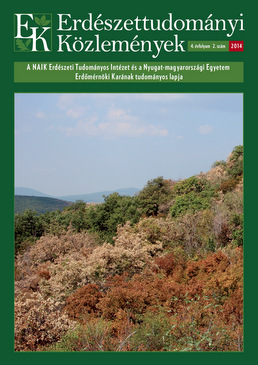| 1. | Berki, I. 1991: Research into the cause of oak decay decline in Hungary. Proceedings of International Symposium on Ecological Approaches of Environmental Chemicals. Debrecen, 8–14. |
| 2. | Berki I. 1995: Az északi-középhegységi kocsánytalan tölgypusztulás néhány okának vizsgálata. Kandidátusi értekezés KLTE, Debrecen |
| 3. | Berki, I. 1993: Die Rolle von Eintrag, Klima und Boden beim Eichensterben in Ungarn. Proceeding „Stoffeitrage aus der Atmosphere und Wald, Bodenbelastung in den Ländern von ARGE ALP und ALPEN-ADRIA”. Berchtesgaden, 248–254. |
| 4. | Berki I. 1995: Éghajlatunk változása és a hazai tölgypusztulás. In: Tar K. et al (eds): Erdő és Klíma Konferencia. Noszvaj, 217–221. |
| 5. | Berki, I. and Tar, K. 1991: Investigation of the Precipitation series in the North Hungarian Mountains with respect to the oak decay. Proceeding of the International Conference of Mountains Meteorology, Climatology and Aerology of the lower layers of Troposphere. Stara Lesna, 36–42. |
| 6. | Csóka Gy. 1992: A hazai kocsánytalantölgy-pusztulás menete 1983-tól napjainkig. Erdészeti Lapok, 127: 313–314. full text |
| 7. | Csóka Gy.; Koltay A.; Hirka A. és Janik G.; 2007: Az aszályosság hatása kocsánytalan tölgyeseink és bükköseink egészségi állapotára. In Mátyás Cs. és Vig P. (eds): Erdő és klíma V., Sopron, 229–239. |
| 8. | Csóka Gy.; Koltay A.; Hirka A. és Janik G. 2009: Az aszályosság hatása kocsánytalan tölgyeseink és bükköseink egészségi állapotára. Klíma-21 füzetek, 57: 64–73. |
| 9. | Csóka, Gy.; Tóth, J. and Koltay, A. 1999: Trends of the sessile oak decline in North -Eastern Hungary. In: Forster, B. et al. (eds): Methodology of Forest Insects Disease Survey in Central Europe. Proceedings of the Second Workshop of the IUFRO WP. 7.03.10. Sion, 48–53. |
| 10. | Csóka, Gy. and Hirka, A. 2011: Alien and invasive forest insects in Hungary (a review). Berichte Freiburger Forstliche Forschung, 89: 54–60. |
| 11. | Czúcz, B.; Gálhidy, L. and Mátyás, Cs. 2011: Present and forecasted xeric climatic limits of beech and sessile oak distribution at low altitudes in Central Europe. Annals of Forest Science, 68(1): 99–108. DOI: 10.1007/s13595-011-0011-4 |
| 12. | Eichhorn, J.; Roskams, P.; Ferretti, M.; Mues, V.; Szepesi, A. and Durrant, D. 2010: Visual assesment of crown condition and Damaging Agents. Manual Part IV. In: Manual on methods and criteria for harmonized sampling, assessment, monitoring and analysis of the effects of air pollution on forest. UNECE ICP Forest Programme Co-ordinating Centre, Hamburg, 49 pp. |
| 13. | Fodor S. 1995: Tölgyhervadás és időjárás. In: Tar K. et al. (eds): Erdő és Klíma Konferencia. Noszvaj, 243–243. |
| 14. | Führer E. 1989: Kocsánytalan tölgyes állományok megbetegedése és az időjárás közötti összefüggés elemzése. Az Erdő, 38(7): 296–296. full text |
| 15. | Führer E. 1990: Beteg és egészséges kocsánytalan tölgy egyedek talajának és levelének összehasonlító elemzése. In: Környezetünk Savasodása. 1990.11.14.-1990.11.16. |
| 16. | Granier, A.; Bréda, N.; Biron, P. and Villette, S. 1999: A lumped water balance model to evaluate duration and intensity of drought constraints in forest stands. Ecological Modelling, 116: 269–283. DOI: 10.1016/s0304-3800(98)00205-1 |
| 17. | Igmándy Z. 1985: A kocsánytalan tölgy pusztulás Magyarországon. Magyar Tudomány, 30: 456–459. |
| 18. | Igmándy Z.; Pagony H.; Szontagh P. és Varga F. 1985: A kocsánytalan tölgy (Quercus petraea MATT./Lieb) pusztulása hazánkban. Növényvédelem, 21(7): 311–311. |
| 19. | Igmándy Z.; Traser Gy. és Vasas E. 1986: A kocsánytalan tölgypusztulás járványtól sújtott törzsek évgyűrűvizsgálata. Növényvédelem, 20(9): 406–406. |
| 20. | Jakucs, P. 1988: Ecological approach to forest decay in Hungary. Ambio, 17(4): 267–274. |
| 21. | Mátyás Cs.; Führer E.; Berki I.; Csóka Gy.; Drüszler Á.; Lakatos F.; Móricz N.; Rasztovits E.; Somogyi Z.; Veperdi G.; Vig P. és Gálos B. 2010: Erdők a szárazsági határon. Klíma-21 Füzetek, 61: 84–97. |
| 22. | Pieczka, I.; Pongrácz, R. and Bartoly, J. 2011: Comparison of simulated trends of regional climate change in the Carpathian basin for the 21st century using three different emission scenarios. Acta Silvatica & Lignaria Hungarica, 7: 9–22. full text |
| 23. | Pretzsch, H. 2009: Forest dynamics, growth and yield. Springer-Verlag Berlin Heidelberg. DOI: 10.1007/978-3-540-88307-4 |
| 24. | Reinecke, L.H. 1933: Perfecting a stand-density index for even-aged forest. Journal of Agricultural Research, 46: 627–638. |
| 25. | Sopp L. 1974: Fatömegszámítási táblázatok. Mezőgazdasági Kiadó, Budapest |
| 26. | Thornthwaite, C.W. and Mather, J.R. 1955: The water budget and its use in irrigation. In Water, The Yearbook of Agriculture. US Department of Agriculture: Washington DC, 346–358. |
| 27. | Tóth J. 1989: Az Erdészeti Tudományos Intézetben folyó erdővédelmi kutatások eredményeinek összefoglalása. Erdészeti Kutatások, 81: 293–294. |
| 28. | Tóth J.; Csóka Gy.; Hirka A.; Koltay A. és Leskó K. 2003: A magyarországi erdők egészségi állapota 2002, aktualitások. A Magyar Tudomány Napja 2002, Konferencia kötet, ERTI kiadvány, 17: 51–61. |
| 29. | Vajna L. 1989: A kocsánytalan tölgy pusztulásának kórok- és járványtani kérdései. Erdő, 38: 169–175. |
| 30. | Vajna, L. 1990: Fungi associated with oak-decline. EPPO Bulletin, 20: 3. |
